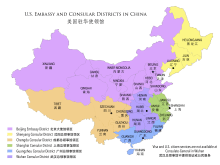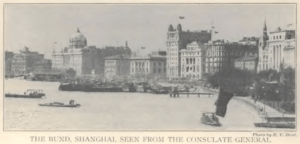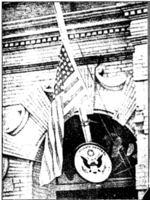Consulate General of the United States, Shanghai
The Consulate General of the United States in Shanghai is one of the six American diplomatic and consular posts in the People's Republic of China.[1]
| Consulate General of the United States of America Shanghai
美国驻上海总领事馆 | |
|---|---|
 Seal of the United States Department of State | |
Incumbent Sean B. Stein since August 2017 | |
| Formation | 1844 (to Qing Dynasty) 1980 (to PRC) |
| Abolished | 1950 - 1980 |
| Website | Click here |

First established in 1844 following the signing of the Treaty of Wanghia, the U.S. Consulate General in Shanghai had a presence until the Communist Revolution in China and it closed in 1950. It reopened in 1980 at its present location at 1469 Huai Hai Zhong Road (at the corner with Urumqi Road) in an early 20th-century mansion.
The Consulate General has two other offices in Shanghai. The Consular Section (American Citizen Services Unit & Nonimmigrant Visa Unit) is located in the Westgate Mall and the Public Affairs Section is located in the Shanghai Centre both on Nanjing West Road.
History
The history of the U.S. Consulate General in Shanghai dates from the earliest days of diplomatic relations between the United States and China. The Consulate General is among the oldest American diplomatic and consular posts in the Far East, and the second oldest in China.[2]
Establishment

The first American consular presence in Shanghai dates to the mid-nineteenth century, following the conclusion of the Treaty of Wanghia, a treaty of "peace, amity, and commerce", between the United States and the Qing Dynasty in 1844. In the absence of an officially appointed consul, American businessman Henry Wolcott — local agent for a Boston trading company — raised the Stars and Stripes above his company office near the Bund and became the first Acting U.S. Consul in Shanghai.
In 1854, in recognition of growing American trade and interests in the port city, the United States Government appointed Robert Murphy the first professional American Consul in Shanghai. His offices were located on Whangpoo Road (now Huangpu Road), north of Suzhou Creek, in the area that would soon become the hub of Shanghai’s American Settlement. As Shanghai’s linkages with the West grew, so too did the American Consulate.
Growth in the 19th Century

President Abraham Lincoln named George Seward to be Consul in 1861 and promoted him to Consul General two years later. He served in that position until 1876 when he was appointed US Minister to China. During his fifteen years in Shanghai, Seward oversaw the expansion of the American Settlement and its merger with the British Settlement and French Concession, creating a joint International Settlement. (The French left the International Settlement soon after.)

In 1874, Seward signed a lease for a consular compound to be built with its main entrance off Woochang Road (now Wuchang Road) and on the banks of the Huangpu River. In 1885, the land was sold and the new owners terminated the lease with effect from 1 February 1889. The consulate moved to new buildings at 12 Kiukiang Road (Jiujiang Road) in what was traditionally considered the British Concession.
The Early Twentieth Century

In 1901, the consulate returned to Hongkew, when Consul General John Goodnow agreed a ten-year lease to take over the old Club de Recrio building at 36 Whangpoo Road on a block away from the previous premises leased by Seward.[3]
By the early twentieth century, more than 1,500 Americans called Shanghai home. The American community contributed to the economy and life of the city, founding businesses, hospitals, schools, and educational exchanges.


In 1911 a lease was signed for the Consulate General to move to six buildings in the Clifton Estate at 13-19 Whangpoo Road to accommodate a quickly growing staff and range of responsibilities.[4] These buildings were occupied by the consulate, prison, post office, and two residences (at nos. 13 and 19). The United States Court for China was located across the private road in No. 11.[5] In 1916, Mr Edward Isaac Ezra purchased the buildings with the intent of developing them. The US Consul General, Thomas Sammons contacted Mr Ezra who agreed to sell the premises to the US Government for the same price he had paid for them. These new offices — at a cost of $355,000 (425,000 taels) — were the most expensive U.S. embassy or consulate in the world at that time. The area was 6.258 mow (4172 square metres) and had a 275-foot (25 metres) water frontage.[6]

The area came to be known as consular row with - starting from Garden Bridge - the Russian, German, American and Japanese consulates all located in a row at the confluence of Suzhou Creek and the Huangpu River.



In the 1930s, after substantial lobbying, it was decided to re-build the Consulate General. In 1930, the U.S. Consulate General moved south of Suzhou Creek, leaving the old American Settlement for the first time in nearly 30 years. The Consulate was first located in the old Kalee Hotel at 248-250 Kiangse Road (now Jiangxi Road). The government offices were located on the Ground Floor and the Consulate and United States Court for China on the first floor. The upper floors were used as accommodation for consular staff.[7] The US Marshall also built the consular jail in as part of the new premises.[8]


The old Whangpoo Road premises were demolished in 1931 and the original plan was that the Consulate would be re-built within a year. However, in 1932, Congress withdrew the appropriations for 1933, leaving the consulate in the old Kalee Hotel building.[9] Appropriations were obtained in 1935 and grand plans for the new consulate announced. These never came to fruition. (The site and the site of the former German Consulate General next door that was demolished in 1937[10] is now the location of the Seagull Hotel which was built in the 1980s).

In 1936, following a decision to raze the old Kalee Hotel, the consulate moved to the newly completed Development Building on the southwest corner of Kiangse Road and Foochow Road (now Fuzhou Road). The 4th and 5th Floor were occupied by the Consulate, the 6th Floor, by the United States Court for China and the United States Treasury attache, with the 7th Floor having 3 suites for consular officers. Other consular officers moved to residential premises in the rest of Shanghai.[11]

By the 1930s, the Consulate General hosted a staff of ten State Department officials, a trade commissioner from the Department of Commerce, and an agent from the Department of Agriculture, as well as the United States Court for China, a jail, wharf, post office, and a parade ground for visiting Navy and Marine detachments.[12]
World War II
On 8 December 1941, the United States Consulate was occupied by the Japanese military at the beginning of the Pacific War. The US Consul, Edward Stanton, reported to the State Department:
"I have received a formal communication today (Dec 8) from the Japanese Consul General reading as follows: 'I have the honour to inform you that I have been instructed by His Imperial Japanese Majesty's Government to request you that the function of the American Consulate General at Shanghai will be here forth suspended and that the office of the American Consulate General be closed as from today. All the officers of the American Consulate General will be treated in accordance with international law and the principle of reciprocity.'"[13]
The Consul and other staff were interned either at home or in the Metropole Hotel across the road from the Consulate for 6 months before being repatriated via Maputo, Mozambique.[14]
On 7 March 1942, the premises were handed over to the Swiss Consul-General in Shanghai, Emile Fontanel. The Japanese authorities requested the premises be handed over for other uses. Having received permission from the State Department, the 6th and 7th Floors were vacated and all archives and property moved to the 4th and 5th Floors. These floors were subsequently given up and the archives and property moved to other premises.[15] The records were returned at the end of the war.[16]

From World War to Cold War

On September 5, 1945, less than a month after Japan’s surrender, the U.S. Consulate General resumed operations in the old Glen Line Building at 28 The Bund. The German Consulate had been located there since 1937 and throughout the war. Post-war Shanghai was a different city; the foreign settlements had been abolished by the Treaty for Relinquishment of Extraterritorial Rights in China and civil war between the Kuomintang government and Chinese Communists soon engulfed the country.
On May 29, 1949, the People’s Liberation Army entered Shanghai. The new Communist government did not recognize the diplomatic status of the Consulate staff, and on April 25, 1950, Consul General Walter McConaughy lowered the American flag and closed the Consulate.[17] It was not until decades later that formal diplomatic relations between China and the United States were reestablished, and the Consulate could reopen.
Rebirth and Renewal
Shanghai itself came to symbolize the normalization of Sino-U.S. relations in 1972, with the issuance of the Shanghai Communiqué. On April 28, 1980, almost exactly 30 years after it closed, the United States Consulate General in Shanghai reopened at its present location at 1469 Central Huaihai Road (at the corner of Urumqi Road). A member of the old Consulate’s Chinese staff later presented Consul General Donald Anderson with the same flag that his predecessor had lowered three decades earlier. It now hangs in the Consulate’s reception rooms as a symbol of the historic ties between the old Consulate and the new.

The current Consulate property was built in 1921. The main house is a villa in the French Renaissance style. Prior to the Consulate assuming the lease, the property hosted numerous and varied occupants. The first was Jardine, Matheson and Co., the largest British trading firm in Asia at the time. During World War II, a Japanese businessman and his family, and later the Swiss Consul General, took up residence in the house. In 1946, Rong Hongyuan (Yung Hungyuen), scion of a wealthy textile family, bought the property, but fled Shanghai soon after. Following the establishment of the People’s Republic of China, the house was used by the All-China Women’s Federation, was a center for "political education" during The Cultural Revolution, and finally served as a government guesthouse prior to the U.S. Consulate taking the lease. The present Consulate property sits on three acres, and includes several outbuildings, an orange grove, a Chinese rock garden, and a carp pond. Extensive renovations, both to the interior and exterior of the building, were carried out in 1997 and 2003-2005 to preserve the beauty of the property and to upgrade the building’s effectiveness as a work place.

As Shanghai continues to grow, and Sino-U.S. relations develop deeper and broader linkages, the work of the U.S. Consulate General in Shanghai also continues to grow and expand. Shanghai has again become a major center of commerce and trade, and is a potent symbol of China’s rising status. American businesses and citizens have returned to the city in large numbers. The Consulate General’s large staff works to support and promote American interests, assist U.S. companies and private American citizens, and promote exchanges and dialogue between Chinese and American individuals and institutions. Much has changed in the past century and a half since the United States established a consular presence in Shanghai, but much has also remained the same: the relationship between the Consulate and Shanghai is as vibrant, dynamic and durable as Shanghai itself.
Consuls General
Post-1980
- Sean B. Stein, 2017-
- M. Hanscom Smith, 2014 - 2017 [18]
- Robert Griffiths, 2011–2014 [19][20]
- Beatrice Camp, 2008-2011 [21]
- Ken Jarrett, 2005–2008
- Doug Spelman, 2002–2005
- Henry (Hank) Levine, 1999–2002
- Ray Burghardt, 1997–1999
- Joe Borich, 1994–1997
- Jerome Ogden, 1992–1994
- Pat Wardlaw, 1989–1992
- Charles Sylvester, 1987–1989
- Thomas (Stan) Brooks, 1983–1987
- Don Anderson, 1980–1983
Pre-1950
Consuls General
- Walter P. McConaughy, 1949-1950[22]
- John M. Cabot, 1948-1949
- Monnett B. Davis, 1946-1947
- Frank P. Lockhart, 1940-1942
- Clarence E. Gauss, 1936-1940 (Later appointed Ambassador to China)
- Monnett B. Davis, 1935-1936
- Edwin S. Cunningham, 1920-1935
- Thomas N. Sammons, 1914-1919
- Amos Parker Wilder, 1909-1914
- Charles Denby Jr., 1907-1909
- James Linn Rodgers, 1905–1907
- John Goodnow, 1897-1905
- Thomas R. Jernigan, 1894-1897
- Alfred Daniel Jones, 1893-1893 (Died in office)
- Joseph A. Leonard, 1889-1893
- General John Doby Kennedy, 1886-1889
- Enoch J. Smithers, 1885–86
- General Julius H. Stahel, 1884–85
- Owen N. Denny 1880-1883
- David H. Bailey, 1879-1880
- G. Wiley Wells, 1877-1879
- John C. Myers 1876-1877
- George F. Seward, 1863–76 (Promoted to Minister to China)
Consuls
- George F. Seward, 1862-1862
- William L.G. Smith, 1858-1862
- George B. Glover, 1858-1858
- Robert C. Murphy[23]
- John N. A. Griswold, 1848-1851
- Henry G. Wolcott, 1845-1848
See also
References
- "Archived copy". Archived from the original on February 19, 2017. Retrieved June 24, 2013.CS1 maint: archived copy as title (link)
- History | U.S Embassy & Consulates in China
- The Consul General's Shanghai Postal Agency 1867-1907, Peter L Koffsky, pp39 et seq
- South China Morning Post, May 24, 1911, p2
- US Consulate General bought, North China Herald, August 19, 1916
- "America's Own Consulate: The Handing Over of the Title Deeds, North China Herald, August 26, 1916, p405
- "Moving Week for U.S. Consulate", North China Herald, Sept 2, 1930, p353
- "United States Consular Offices Find New Home in Old Kalee Hotel Shell", China Press, August 24, 1930, p1
- "Building of U.S. Consular Premises Again Postponed", The China Weekly Review, April 9, 1932.
- "Another Landmark to be Razed, German Consulate to be Rebuilt", North China Herald, March 10, 1937, p413
- "U.S. Consulate Starts Moving Today", The China Press, March 24, 1936.
- History of the United States Consulate in Shanghai, US Embassy and Consulates in China
- "Officials kept in Hotel", New York Times, December 9, 1941.
- New York Times, "US Officials kept in Hotel, December 9, 1941 and "Gripsholm brings 1,500 from the Orient" August 26, 1942
- United States Department of State / Foreign relations of the United States diplomatic papers, 1944. The Near East, South Asia, and Africa, the Far East (1944), p1181, Report from the Swiss Consul-General in Shanghai to Swiss Legation in Tokyo.
- Records of the United States Court for China, American Journal of Legal History, Vol. 1, No. 3 (Jul., 1957), pp. 234-235
- Time Magazine, May 15, 1950
- "Archived copy". Archived from the original on May 2, 2013. Retrieved June 24, 2013.CS1 maint: archived copy as title (link)
- "Archived copy". Archived from the original on May 2, 2013. Retrieved June 24, 2013.CS1 maint: archived copy as title (link)
- http://www.chinamedia.com/news/2012/04/30/american-diplomat-believes-its-all-about-interaction/
- Shanghai: With Beatrice Camp
- "33 Men Have Headed Local U.S. Consulate Since 1845", the China Press, Sept 8, 1935, p9
- See also Robert Creighton Murphy: U.S. Consul at Shanghai, Brigade Commander, National Scapegoat, 1854-1857, Association for the Preservation of Historic Congressional Cemetery, Fall 2002, Newsletter, p4